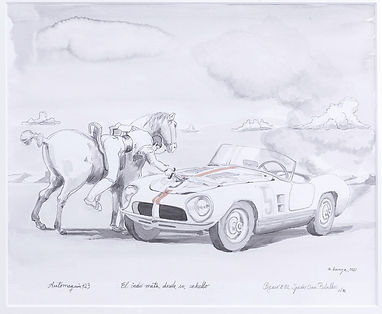Automáquias

From the series of calcographic engravings titled The bullfighting by Francisco de Goya (1816), replace the bull with an artificial beast, a car.
The serie begins by substituting the fighting bull for thepegasus z102,a sports car designed and built in Spain in the 1950s with the intention of promoting trucksPegasusof the post-war automotive industry, and in turn functioned as an emblem of what we know today as the "country brand", wanting to expand a commercial sensation to the world under the positivist idea of "...Spain is doing well"...

Automaquia # 30
Pedro Romero le entra a uno parado
(Pegaso z102 Spider ENASA Pedralbes, (ref.80), 1954)
Tinta China y acuarela sobre papel. 30 x 45 cm

Automaquia # 2
Otro modo de cazar ... (Pegaso z102 Spider Touring Competición 1953)
Tinta China y acuarela sobre papel. 70 x 100 cm

Automaquia # 23
El indio mata desde su caballo
(Pegaso z102 Spider ENASA Pedralbes (ref 82), 1954)
Tinta China y acuarela sobre papel. 30 x 45 cm

Automaquia # 11
Lanceando otro
(Pegaso z102 BT1 (ref 29), 1953)
.....The Italian designer of the italian Touring enterprises, make a homage to iberian Bull´s snout on its 1952 car body.
China ink and watercolor 70 x 100 cm.

Dibujo para Automaquia # 19
(Pegaso z102 Bisiluro, BS2 1954)
Acrylic and graphite on facsimile drawing by Francisco de Goya edited by Museo del Prado (1974). 24x32 cm.

Automaquia de Burdeos Nº1
Acrylic and graphite on facsimile lithograph by Francisco de Goya. 42x53 cm.

Automaquia # 29
“Haciendo el recorte” Pegaso z102 Spider Serra
Acrylic and graphite on original engraving by Francisco de Goya. . (8ª Edition Calcografía Nacional 1983). 49 x 59 cm.

Automaquia # E
“Haciendo el recorte” Lamborguini Marzal
Acrylic and graphite on facsimile engraving by Francisco de Goya.

Automaquia # 4
“capean otro encerrado” Lamborgini Diablo
Acrylic and graphite on facsimile engraving by Francisco de Goya.

Automaquia # 46 “capean otro encerrado” Lamborgini Diablo
Acrylic and graphite on facsimile engraving by Francisco de Goya.